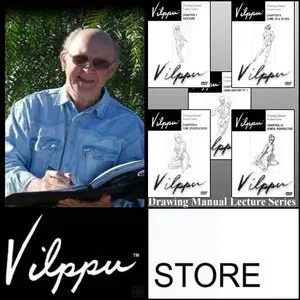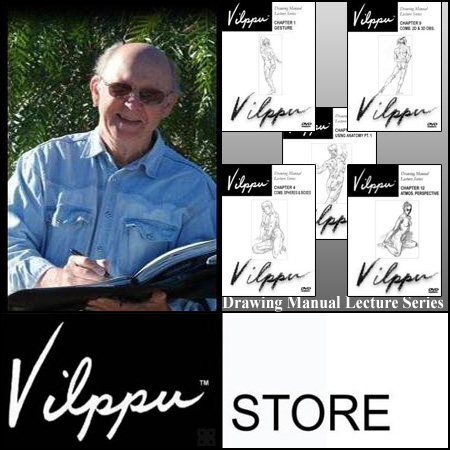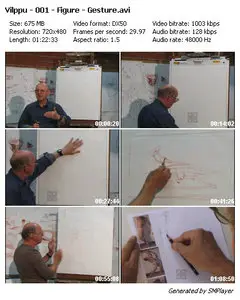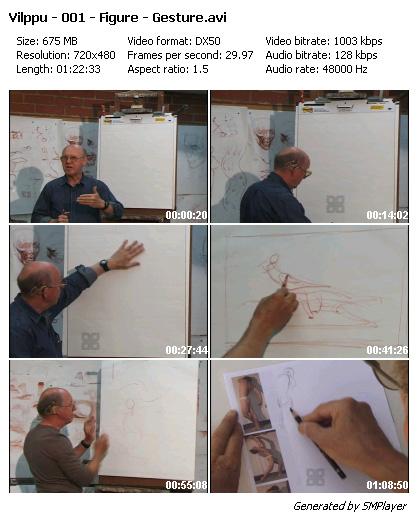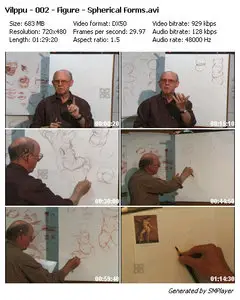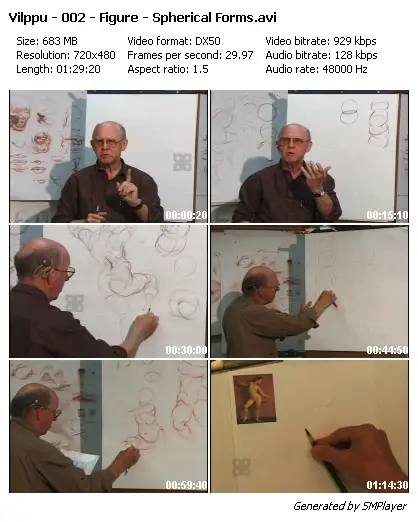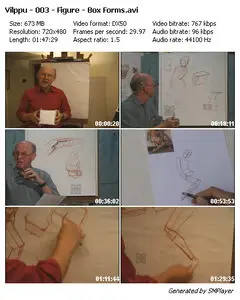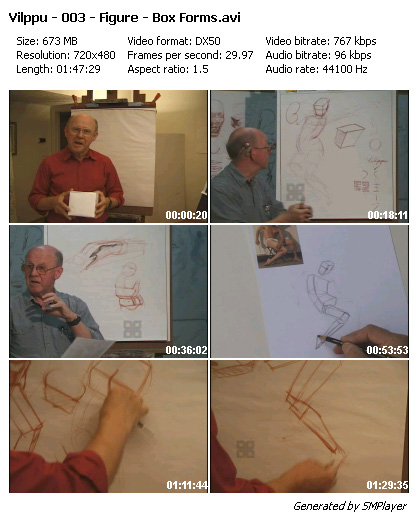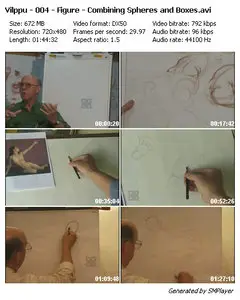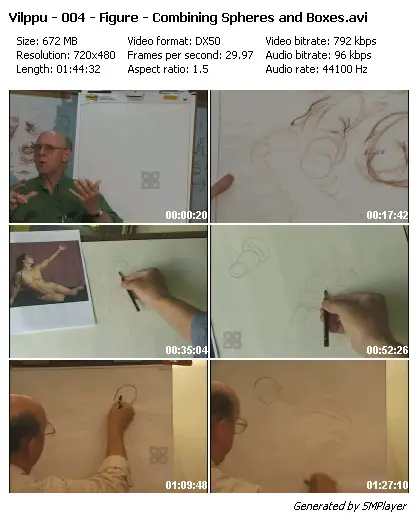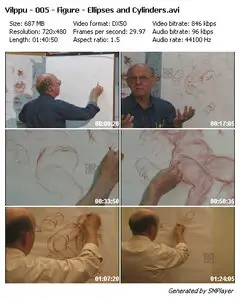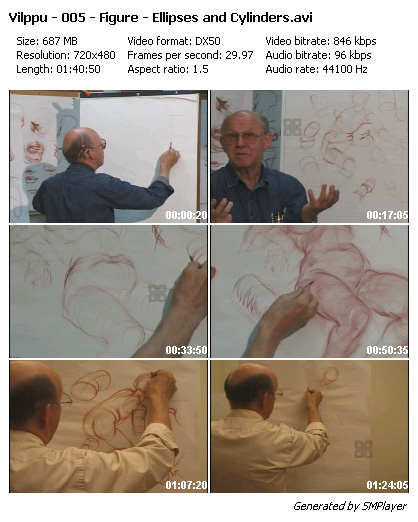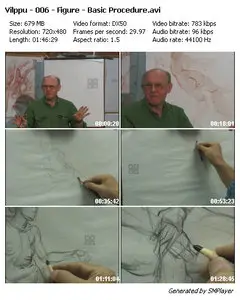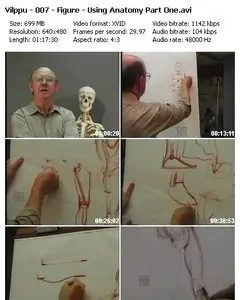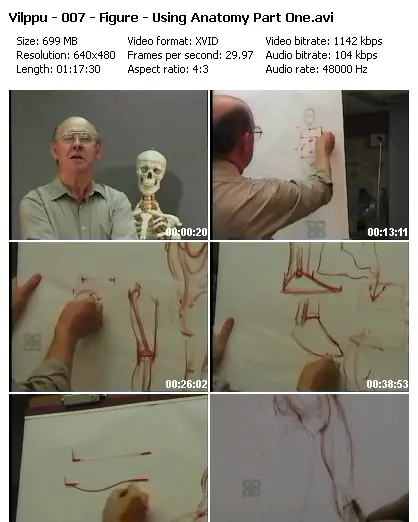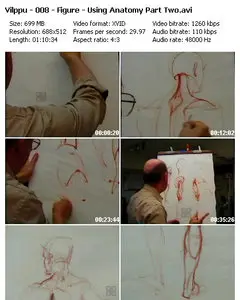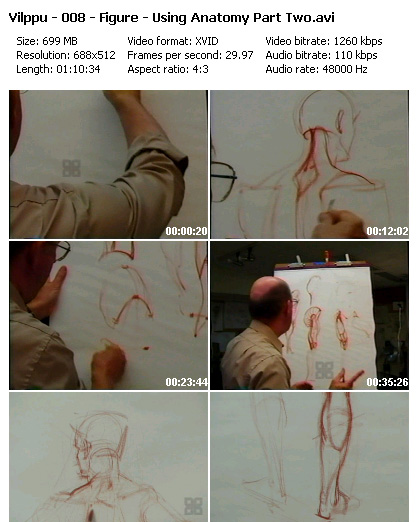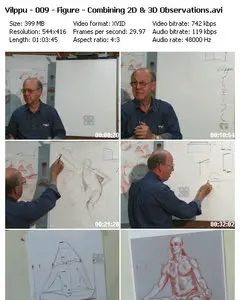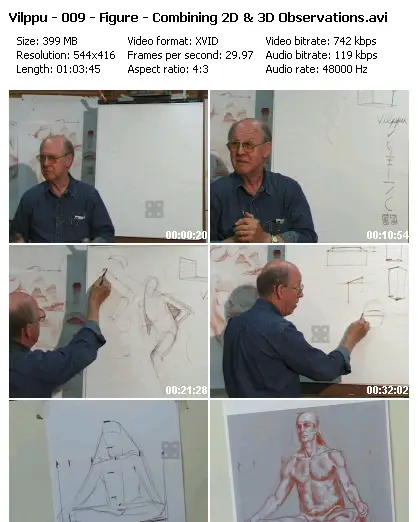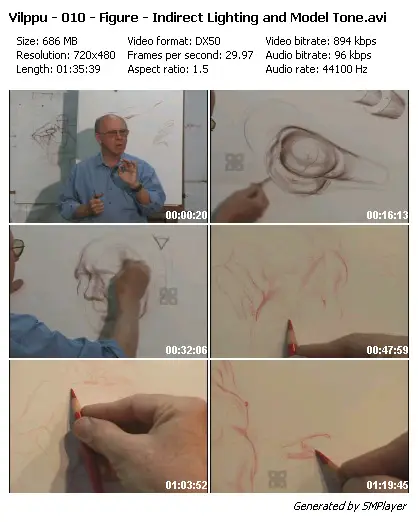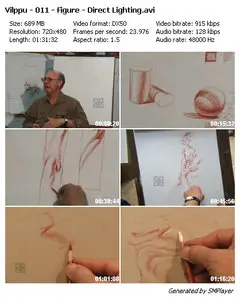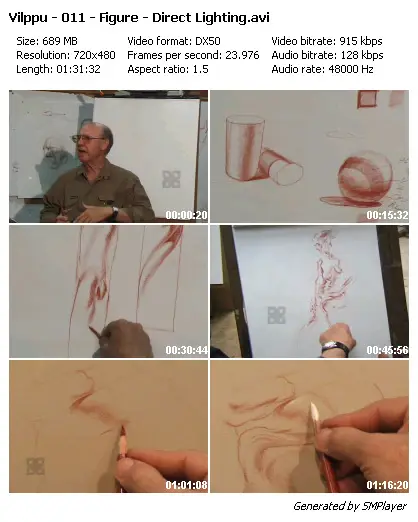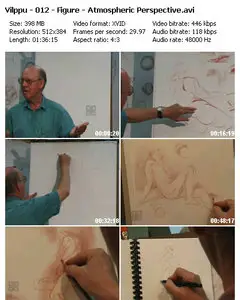This series follows along with the chapters in the Vilppu Drawing Manual. Each DVD covers one chapter. All combine for an excellent study of drawing and Glenn's philosophy around drawing (which even extends to the way he lives).
Chapter 1: Gesture
"Gesture is the single most important element in the drawing". The action of the figure is usually expressed as "gesture". It means the movement and attitude of the figure. It is body language and all of those subtle differences that characterize individuals, be they human or animal. Glenn breaks this down into a series of steps that are easy to understand and apply.
Screenshot
English | 1h 22min | AVI | 720x480 | 29.97 fps | DivX5 @ 1004 kbps | MP3 @ 128 kbps | 675 MB
Download from FileServe
Part 1 | Part 2 | Part 3 | Part 4
Download from Sharingmatrix
Part 1 | Part 2 | Part 3 | Part 4
Download from Rapidshare
Part 1 | Part 2 | Part 3 | Part 4
Chapter 2: Spherical Forms
Now that you've mapped out the action of the pose, the next step in the process is to define your figure in 3-D space. Learning to see your subject in terms of simple shapes and forms along with values is one of the basic elements in learning to draw. Glenn breaks this down into a series of steps that are easy to understand and apply.
Screenshot
English | 1h 29min | AVI | 720x480 | 29.97 fps | DivX5 @ 930 kbps | MP3 @ 128 kbps | 683 MB
Download from FileServe
Part 1 | Part 2 | Part 3 | Part 4
Download from Sharingmatrix
Part 1 | Part 2 | Part 3 | Part 4
Download from Rapidshare
Part 1 | Part 2 | Part 3 | Part 4
Chapter 3: Box Forms
The box is like the sphere in Lesson 2. It is a critical form that you must learn how to draw if you are serious about developing your drawing skills. The ability to draw the box is a necessary basic skill. If you don't have a complete mastery of this, it will hinder your development as an artist. Glenn breaks this down into a series of steps that are easy to understand and apply.
Screenshot
English | 1h 47min | AVI | 720x480 | 29.97 fps | DivX5 @ 768 kbps | MP3 @ 96 kbps | 673 MB
Download from FileServe
Part 1 | Part 2 | Part 3 | Part 4
Download from Sharingmatrix
Part 1 | Part 2 | Part 3 | Part 4
Download from Rapidshare
Part 1 | Part 2 | Part 3 | Part 4
Chapter 4: Combining Spheres and Boxes
In lessons 2 & 3 we developed our skills at handling spheres and boxes, manipulating them, and giving them personalities. In this lesson, we combine them and at the same time introduce two new elements. Glenn breaks this down into a series of steps that are easy to understand and apply.
Screenshot
English | 1h 44min | AVI | 720x480 | 29.97 fps | DivX5 @ 792 kbps | MP3 @ 96 kbps | 673 MB
Download from FileServe
Part 1 | Part 2 | Part 3 | Part 4
Download from Sharingmatrix
Part 1 | Part 2 | Part 3 | Part 4
Download from Rapidshare
Part 1 | Part 2 | Part 3 | Part 4
Chapter 5: Ellipses and Cylinders
In the first four lessons, we have been basically dealing with the torso of either human, animal or cartoon characters without actually calling them that. In this lesson we want to expand on that direction by adding appendages to these basic forms. The primary skill required to do this is being able to draw cylinders. Glenn breaks this down into a series of steps that are easy to understand and apply.
Screenshot
English | 1h 40min | AVI | 720x480 | 29.97 fps | DivX5 @ 846 kbps | MP3 @ 96 kbps | 688 MB
Download from FileServe
Part 1 | Part 2 | Part 3 | Part 4
Download from Sharingmatrix
Part 1 | Part 2 | Part 3 | Part 4
Download from Rapidshare
Part 1 | Part 2 | Part 3 | Part 4
Chapter 6: Basic Procedure
In the first five lessons, we have gone through the basic elements, or tools, that we use to create form. All of the work we have done so far has been on the presumption that we were doing a procedural drawing where one element was built on top of the previous rather than a direct type of drawing where each line essentially was the finished line. In this lesson, I will outline a basic procedure showing how all of the elements that we have discussed so far fit in. The essence of this approach is that we go from the general to the specific. Glenn breaks this down into a series of steps that are easy to understand and apply.
Screenshot
English | 1h 46min | 720x480 | 29.97 fps | DivX5 @ 784 kbps | MP3 @ 96 kbps | 679 MB
Download from FileServe
Part 1 | Part 2 | Part 3 | Part 4
Download from Sharingmatrix
Part 1 | Part 2 | Part 3 | Part 4
Download from Rapidshare
Part 1 | Part 2 | Part 3 | Part 4
Chapter 7: Using Anatomy Part One
It is a truism that you cannot draw something unless you know what it looks like. It is also true that just because you know something very well, it does not mean that you can draw it. I have taught many medical personnel, including doctors, nurses, and various specialists with much more understanding of anatomy than myself. In fact, it took a while for me to realize that just knowing anatomy would not make me draw better. What I needed was a method of understanding anatomical facts so I could use these landmarks as a tool of communication and expression without violating basic anatomical reality and thereby detracting from the drawing what it was trying to communicate. Glenn breaks this down into a series of steps that are easy to understand and apply.
Screenshot
English | 1h 17min | 640x480 | 29.97 fps | XviD 1142 @ 1142 kbps | MP3 @ 128 kbps | 699 MB
Download from FileServe
Part 1 | Part 2 | Part 3 | Part 4
Download from Sharingmatrix
Part 1 | Part 2 | Part 3 | Part 4
Download from Rapidshare
Part 1 | Part 2 | Part 3 | Part 4
Chapter 8: Using Anatomy Part Two
In the last lesson, we concentrated on the specific landmarks of anatomy we use with the symmetry of the figure to help us see and draw the action of the figure. The next step in using anatomy is learning to see the large anatomical masses. In the first four lessons we laid much of the groundwork by concentrating on simple forms as a means of analyzing the figure as a total. This lesson is a continuation of that procedure, breaking those larger units into smaller units, while at the same time adding a new level of believability to our drawings. Glenn breaks this down into a series of steps that are easy to understand and apply.
Screenshot
English | 1h 10min | AVI | 688x512 | 29.97 fps | XviD @ 1261 kbps | MP3 @ 128 kbps | 699 MB
Download from FileServe
Part 1 | Part 2 | Part 3 | Part 4
Download from Sharingmatrix
Part 1 | Part 2 | Part 3 | Part 4
Download from Rapidshare
Part 1 | Part 2 | Part 3 | Part 4
Chapter 9: Combining 2D & 3D Observations
The reality of drawing is that we draw on a two dimensional piece of paper; the drawing is not a three dimensional object. Up to this point, our efforts have been almost exclusively concerned with creating that three dimensional illusion on a two dimensional surface. We used a series of tools and procedures that didn't necessarily rely on the model, but on an analytical and constructive approach to drawing the figure. In drawing from the model, i.e. reality, rather than from imagination or an ideal, we must develop a set of visual tools to help us make that translation from the real three dimensional world (3-D) to the flat two dimensional world (2-D) of the paper. Glenn breaks this down into a series of steps that are easy to understand and apply.
Screenshot
English | 1h 3min | 544x416 | 29.97 fps | XviD @ 742 kbps | MP3 @ 128 kbps | 399 MB
Download from FileServe
Part 1 | Part 2 | Part 3
Download from Sharingmatrix
Part 1 | Part 2 | Part 3
Download from Rapidshare
Part 1 | Part 2 | Part 3
Chapter 10: Indirect Lighting and Model Tone
The first half of this manual has been primarily concerned with creating form using line, emphasizing the need to visualize the whole form and to draw across the surface of the form to show its volume. In learning to see spheres, boxes, and cylinders, we focused on seeing the corners of forms and used these basic visual tools to help us see the orientation of the forms in space and to draw them. In reality, we see things primarily in tone, not line. In this chapter, and the next two, we will discuss three distinct methods of using tone. The three approaches, which are indirect lighting, direct lighting, and atmospheric perspective are distinct but generally used in various degrees together. Glenn breaks this down into a series of steps that are easy to understand and apply. Covers the concept of modeling tone.
Screenshot
English | 1h 35min | AVI | 720x480 | 29.97 fps | DivX5 @ 895 kbps | MP3 @ 96 kbps | 686 MB
Download from FileServe
Part 1 | Part 2 | Part 3 | Part 4
Download from Sharingmatrix
Part 1 | Part 2 | Part 3 | Part 4
Download from Rapidshare
Part 1 | Part 2 | Part 3 | Part 4
Chapter 11: Direct Lighting
In the last chapter, we discussed indirect lighting, the modeling tone, and started on atmospheric perspective, which we will be dealing with more in Chapter 12. Direct lighting is what we normally see when we have a strong single light source. Sunlight on a clear day is an example. The basic elements of direct lighting are highlights, halftone, core, reflected light, and cast shadow. Glenn breaks this down into a series of steps that are easy to understand and apply. Covers the concepts of; core, cast shadow and reflected light.
Screenshot
English | 1h 31min | AVI | 720x480 | 23.976 fps | DivX5 @ 916 kbps | MP3 @ 128 kbps | 690 MB
Download from FileServe
Part 1 | Part 2 | Part 3 | Part 4
Download from Sharingmatrix
Part 1 | Part 2 | Part 3 | Part 4
Download from Rapidshare
Part 1 | Part 2 | Part 3 | Part 4
Chapter 12: Atmospheric Perspective
Atmospheric perspective is normally discussed in conjunction with landscape painting since its true effect is primarily seen in nature in conjunction with great distances in space. The figurative artist has taken this sense of atmosphere and developed it as a strong tool of expression by abstracting the main elements and learning to use them while describing form. In the last two chapters, I have already indicated some of the main elements involved in atmospheric perspective. First, the graying and loss of detail as objects recede in space due to more atmosphere coming between the viewer and the object. Second, the use of this phenomenon in a formulaic manner by artists to separate forms. In this chapter, using the idea of atmosphere will be expanded upon to include its use as a basic element of design in drawing to enhance the action of the figure and to clarify the three dimensionality of the form. Glenn breaks this down into a series of steps that are easy to understand and apply.
Screenshot
English | 1h 36min | AVI | 512x384 | 29.97 fps | XviD @ 446 kbps | MP3 @ 128 kbps | 399 MB
Download fromFileServe
Part 1 | Part 2 | Part 3
Download from Sharingmatrix
Part 1 | Part 2 | Part 3
Download from Rapidshare
Part 1 | Part 2 | Part 3


